“Retourner le rêve à la manière d’une chaussette que l’on retire.” Alberto Savinio and French Surrealism
Alice Ensabella Alice Ensabella Alberto Savinio, Issue 2, July 2019https://www.italianmodernart.org/journal/issues/alberto-savinio/
Although Savinio defined himself as a non-Surrealist painter, and the artist’s relationship with French surrealism has, in part, already been studied, this paper aims shed new light on Savinio’s relationship with the French movement during his second Parisian period (1926–33). This relationship will be analyzed both in terms of the artist’s participation in surrealist group initiatives and shared stylistic influences, focusing particularly on works from the same period by René Magritte and Max Ernst. Additionally, as the surrealists were also collectors, this presentation will address Savinio’s reception within the surrealist group—both as a painter and as a writer.
Critics often describe Alberto Savinio’s connections with French surrealism as a brief passage, relating it to his connections with “ousted” members of the group, including Jean Cocteau, Georges Bataille, and Roger Vitrac, or to aspects of his poetics.1 Pia Vivarelli for her part identifies the main tangency of Savinio and surrealism in the use of imagination: “The real significant point of contact between Savinio and the French movement is in the common trust in imagination as an efficient instrument to expand the concept of truth […] the revelation of the marvelous emerging from the rupture of the everyday logic.”2 On the other hand, Paolo Baldacci points out the deep differences between metaphysical theory and surrealism, showing that the two interpretations of the real were conceptually far apart and based on different prerequisites.3
The tangencies and dissimilarities between Savinio’s ideological structure and the basics of surrealism have already been deeply analyzed.4 Suffice it to say that the main disparity between the two is essentially that while automatism is the basis of surrealism, the concept is completely absent in Savinio’s metaphysical démarche. The metafisica has a more philosophical and conceptual structure in its questioning of systems of perception and the communicative power of images. Nothing is spontaneous in Savinio’s paintings or writings: every image has a specific meaning and cannot be exclusively explained in a psychoanalytic key, that is, as a representation of the artist’s unconsciousness. By this reasoning, most critics agree that Savinio should not be considered a surrealist artist.
Nevertheless, Savinio’s work had significant impact on surrealist aesthetics, as Breton notes in his 1940 Anthologie de l’humour noir (Anthology of black humor): “The whole, as-yet-unformed modern myth rests at its origins on the two bodies of work that are almost indistinguishable in spirit – by Alberto Savinio and his brother, Giorgio de Chirico.”5 Savinio throughout his career took inconsistent and contradictory positions concerning his relation to the French movement. When he arrived in Paris in 1926, he seemed to adopt his brother’s position, and wrote about the surrealists as “signori sforniti d’ingegno” (gentlemen without intelligence).6 Eight years later, having retuned to Italy after seven years in the French capital, he recognized himself as one of the movement’s precursors: “Now, if I am making an apology of surrealism and at the same time I move some critics to it, which I consider fair, it is because I am – in the founders’ opinion – one of the first initiators of this effort of supreme poetry, naked of any trace of bourgeoisism, conventionalism, of low realism.”7 In 1945, in a late text on surrealism, Savinio stated: “Talking about my surrealism, if it is correct to talk about surrealism, it is exactly the opposite as it does not need to represent what is shapeless or to express the unconscious, but it wants to give a shape to what is shapeless, a consciousness to the unconscious.”8
In sum, Savinio declared himself a precursor to the surrealists and talked about his own surrealism, while also asserting that he felt conceptually far from the movement. If we look at the first paintings he realized in Paris, between 1926 and 1933, it is impossible to not to notice echoes and elements of surrealist aesthetics. In an effort to clarify these ambiguities, this essay reconsiders Savinio’s second Parisian period and his relationship with French surrealism through three approaches. The first concerns the contextualization of Savinio’s early works in Paris and retraces possible points of tangency and collaboration with the surrealist group as of the end of World War I. The second focuses on the iconographical and iconological influences of surrealist aesthetics on the Italian artist, specifically by comparing his works with paintings and collages by his contemporaries René Magritte and Max Ernst. The third and last approach will consider the reception of Savinio’s work as both a painter and a writer by the surrealist group.
Paris/Italy: Savinio’s Connections with Dada and surrealism (1919–33)
The first members of the Dada-surrealist group already knew of Savinio’s literary efforts thanks to Guillaume Apollinaire. In a letter from Breton to Louis Aragon dated January 30, 1919,9 Savinio appears in a list of collaborators on a new review, which would become Littérature, published for the first time two months later. Savinio did not in fact take part in the project – for reasons that remain unknown – but it seems that the Littérature group continued to follow his publications. One year later, in June 1920, Savinio’s name resurfaced in a surrealist game that consisted of giving a grade, from -20 to 20, to a long list of “most important writers ever” (figure 1).
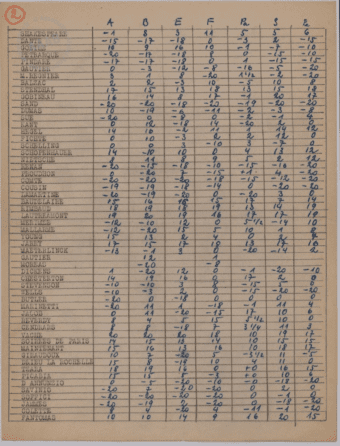
On the original list,10 Aragon, Paul Éluard, and Théodore Fraenkel showed their total disdain for the Italian writer, giving Savinio a determined “-20;” Jean Paulhan and Benjamin Péret expressed indifference, with a “0”; and Philippe Soupault demonstrated a little interest, with a “2.” Only Breton seemed to appreciate, even if modestly, Savinio’s work: he gave him a “7.”
After a period of apparent distance from the Parisian milieu, Savinio arrived in the city in June 1924 and soon met Breton in person. At the time Breton was working on the surrealist manifesto that he would publish just four months later.11 Simone Kahn, his first wife, described her own encounter with Savinio in a letter to her cousin Denise Lévy, dated July 7:
I met an interesting guy: Savinio, de Chirico’s brother. […] Savinio has the same mind as de Chirico, this mix of myth and humor. Certainly smarter than him and so unkind. Always above the things he talks about, he has the firmness of people who only deeply know what they know and this unmovable sense of what is the high thought and pure poetry. He is little, dark haired, nearsighted, a bit fat, and he speaks combining a lot of words. André appreciates him a lot.12
Just a few months later, on November 9, Savinio was mentioned in the “Cahier de la permanence surréaliste”13 as one of the contributors to Lé Révolution surréaliste. Though he would not publish a single text in that review, nor reproduce any of his paintings in it, the presence of his name suggests that his contact with the surrealists was still lively. Indeed, not much later, in January 1925, Savinio’s play La morte di Niobe (The death of Niobe) was advertised in that very review.14
When Savinio moved to Paris in July 1926, he was already in contact with the surrealist milieu and his brother was already well established in the art market. Savinio started his career as a painter on the privileged right bank, making contact with and even receiving commissions from some of the most powerful dealers of the time.15 Léonce Rosenberg purchased Savinio’s paintings, published them in the Bulletin de l’Effort modern,16 and in late 1928, commissioned a series of six paintings of “transparent cities” for his apartment on the rue de Longchamp.17 Another great dealer on the prestigious rue La Boétie, Paul Guillaume, bought several of Savinio’s paintings, and it is through Guillaume that the artist was introduced to Jeanne Castel, who in 1928 would become his first dealer. The most important event in this period was, without a doubt, Savinio’s solo exhibition at the Jacques Bernheim gallery, which lasted from October 20 to November 5 and displaying the artist’s work from 1926 to 1927. Jean Cocteau wrote an introduction to the catalogue accompanying this show (figure 2).
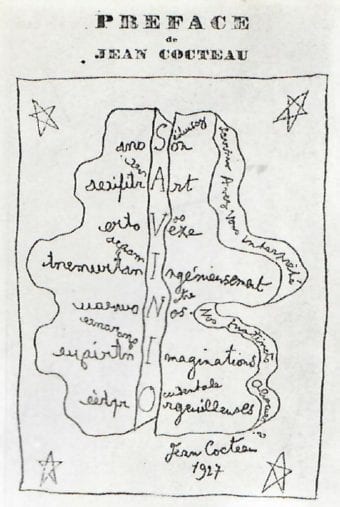
On this occasion, eighteen of the twenty-nine paintings in the exhibition sold.18 Therefore, Savinio met remarkable success in the French capital and would keeping exhibiting his paintings in the following years with the group called “Les Italiens de Paris.”19
This context seems to place Savinio at a distance from surrealist activities and shows. Though his wife, Marina Morino, recalled that in Paris they used to go to Breton’s atelier at 42 rue Fontaine,20 Savinio’s paintings never appeared in surrealist exhibitions at the time. Indeed, his canvases were never at the Galerie Surréaliste – in existence between March 1926 and December 1928 – as far as can be gathered from the gallery’s advertisements.21 Savinio’s paintings were likewise not reproduced in the official magazines of surrealism, La Révolution surréaliste (1925–29) and Le Surréalisme au service de la révolution (1930–33). However, his name appeared in the latter, for the first and last time, in May 1933, in connection to the French version of his text Achille innamorato misto all’Evergeta (1929), which was published in 1933 as Achille Énamouré Mêlé à l’Evergète22 – evidence that in 1933 he was maintaining contact with the Parisian surrealist group.
Therefore, despite the facts that his brother was at the time already in conflict with surrealists for the classical revolution in his painting, that he was supported by dealers far removed from the surrealist circle, and that he never formally took part to their exhibitions, Savinio during these Parisian years was surely close to and fascinated by surrealist painting. Evidence of this proximity can be identified in stylistic and iconographical influences of the surrealist aesthetic on Savinio’s painted output. This relationship comes to light when one views the oeuvres of two artists, in particular: René Magritte and Max Ernst.
Savinio, Magritte, and Ernst: Toys, Forests, and Collages
While no evidence of direct exchanges between Magritte and Savinio has been found, their artistic research was certainly interconnected. Furthermore, in the years between 1927 and 1930, it is known that the two artists saw one another’s work. Magritte had his first two solo shows in Brussels in April 1927 and January 1928 at the Galerie Le Centaure, but as of 1927 he was already living and keeping his atelier in Paris, in Perreux-sur-Marne. Breton bought paintings by the Belgian painter at the beginning of 1928, and Camille Goemans, a dealer and founder of the surrealist group in Brussels, exhibited his works in the permanent display at his gallery on the Parisian left bank, which opened that same year.23 Magritte’s works were also on view in this period at the Galerie Van Leer, as advertised in La Révolution surréaliste (figure 3).24
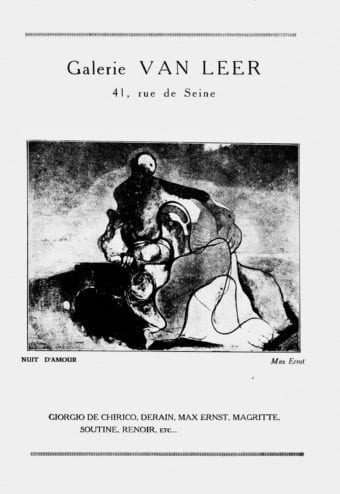
Savinio surely had the chance to see Magritte’s works at Breton’s home, and at the galleries of Goemans and Van Leer, both in Saint-Germain-des-Près, the neighborhood where Savinio was living.25 Magritte’s oeuvre was deeply influenced by Giorgio de Chirico’s paintings. For example, it is widely accepted that the recurrence of statues and mannequins in Magritte’s work (see La statue volante [The flying statue], 1932–33) can be read as citations of de Chirico. The similarities between Savinio and Magritte could, therefore, be a consequence of the fact that they shared de Chirico as a model. Nevertheless, some elements found in Savinio and Magritte’s paintings are not observable in de Chirico’s, and should be considered to result from a their own “dialogue.”
A common element in the works of Savinio and Magritte is the creation of an imaginary world through a technique – that is perhaps best encapsulated by the term “painted collage” – wherein images cut as silhouettes from different semantic areas and contexts are gathered to form fantastic portraits and landscapes. The medium that makes possible this coexistence of different components is theater. Both artists created, in their images, various mise-en-scènes: Savinio set his compositions on stage (figure 4), while Magritte framed his with curtains (figure 5).
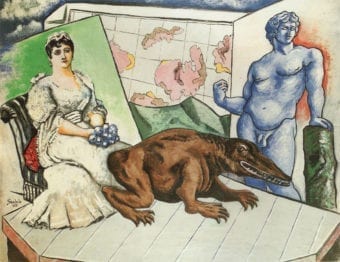
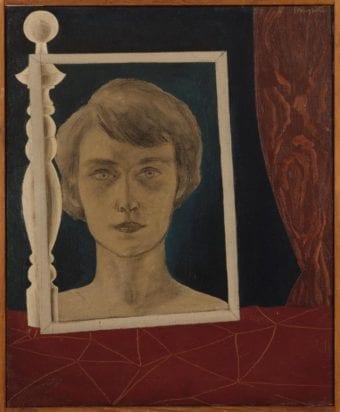
Another element in Savinio’s and Magritte’s shared artistic vocabulary is the presence of characters seen from behind. This kind of portraiture has its genesis in Romantic culture, which was for both artists an important precedent. The romantic Rückenfigur – a German term designating a standing figure contemplating a landscape – was employed by Savinio in these years to represent melancholic figures including the Titans (figure 6), symbols of the loss of human identity. In Magritte (figure 7), the figure-from-behind holds the same pose as the viewer in front of the painting: it might embody any of us, and in this it lacks any specific identity.
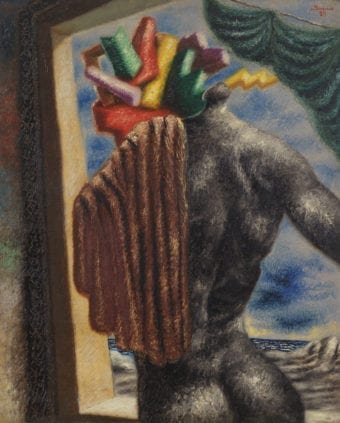
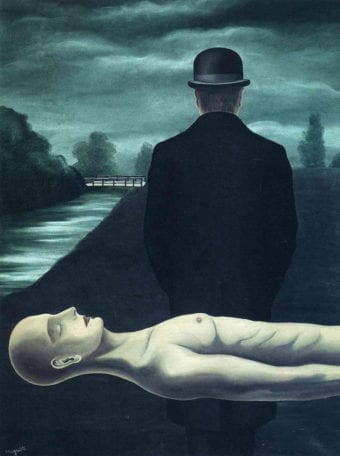
The main iconographical component common to the paintings of both Magritte and Savinio is the representation through toys of childhood memories. In Savinio’s series of Monumenti ai giocattoli (Monuments to toys; figure 8), groups of toys – or rather, toy-shaped objects – appear abandoned on a seashore or in the forest, as symbols of lost childhood. In Magritte’s compositions, these toys are always represented through a bilboquet, an object that can take different forms, including anthropomorphic ones (figure 9); it primarily symbolizes the artist’s childhood and comes from his specific memory of playing with a little girl in a cemetery.26
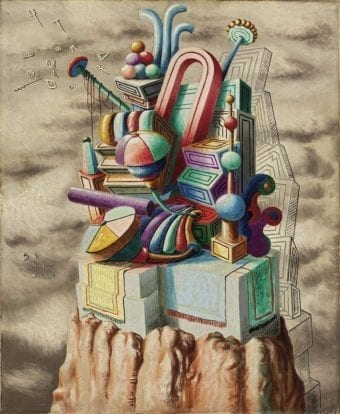
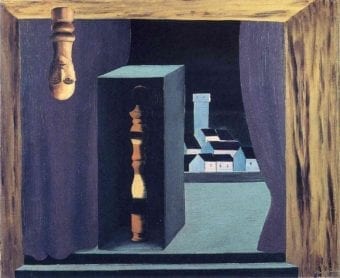
It is interesting to note how both of these artists put their painted toys into different landscapes – Savinio often rendered his forms on deserted islands representing the place of his childhood, while Magritte typically placed his in interior spaces (figure 10) or fantastical landscapes. Strikingly, in a few contemporaneous examples both represented toys in a forest, which could be in reference to the symbolic place of childhood in Romantic culture. In works such as Magritte’s Une image dans la forêt (A figure in the forest; figure 11) and Savinio’s Objets dans la forêt (Objects in the forest; figure 12), both of which were created in 1928, it is evident that the two artists were working with the same iconography, even if it is impossible for the moment to establish who initially influenced the other.
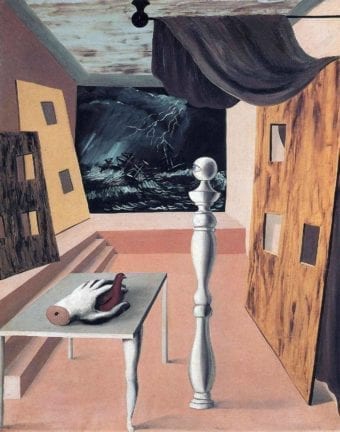
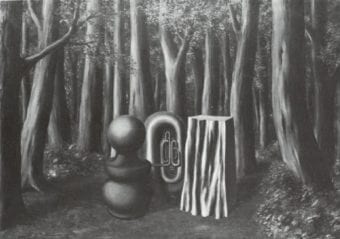
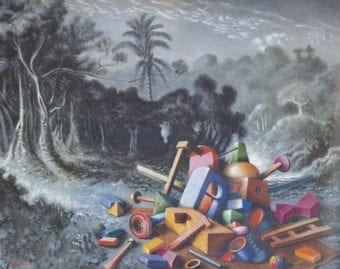
In the same period of years, Max Ernst was working on his famous series of forests (La forêt)27 often realized through the technique of frottage, which he adapted to oil painting by scraping paint from prepared canvases laid over materials. These canvases by Ernst typically contain a wall of trees, a solar disk, and an apparition of a bird in the foliage. As a subject, the dense forest manifested as the sublime embodiment of both enchantment and terror, and as the artist himself attested, the forest symbolized his childhood experiences in the German forest.28 So, in this sense, the parallel with Savinio’s forests is even more pertinent: the forests are not only close stylistically – with their sculptural representations of trees and multicolored skies – but also symbolically – for in Ernst, as well as in Savinio, they are related to memories of childhood.
Ernst exhibited the first works of his forest series in his second solo exhibition at the Galerie Van Leer, from March 15 to April 5, 1927. Savinio was then in Paris and certainly would have seen these works. No record of direct contact between Savinio and Ernst has yet been found in their private correspondences, but it is certain that they worked closely on the decoration of Léonce Rosenberg’s apartment in late 1928 and early 1929. Ernst created a number of paintings in the series Fleures et coquillages (Flowers and shells) for Madeleine Rosenberg’s room, and Savinio produced the aforementioned series Città trasparenti (Transparent cities) series for Lucienne Rosenberg’s room. They both attended the opening night of the dealer’s apartment, and signed and drew in the guest book (figures 13–14).29
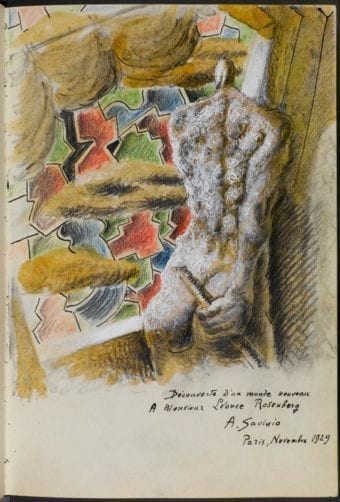
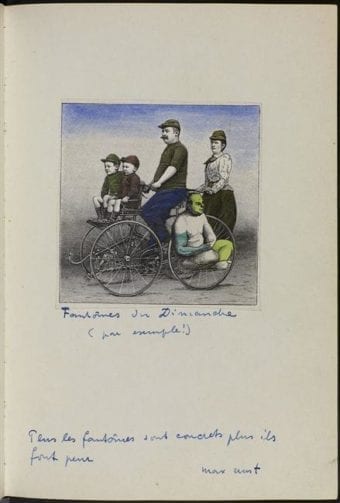
Thus, Ernst and Savinio were certainly in contact around the time that Ernst published his first collage novel, La Femme 100 têtes (The hundred headless woman, 1929; figure 15),30 which features a loose narrative of strangely captioned surrealist images, made by cutting up and reassembling nineteenth-century illustrations. Ernst’s French title has a double meaning: when read aloud it can be understood as either “the hundred-headed woman” or “the headless woman.” Along with this enigmatic title character, the book marks the introduction of Ernst’s favorite alter ego, Loplop, “the Bird Superior.” Some of the collages included in this volume were displayed beginning on December 21, 1929, at Galerie Jeanne Bucher, where Savinio certainly would have had the chance to see them (the gallery was also exhibiting de Chirico’s work then).31 In the spring of 1930, hybrid figures, including with bird heads, started appearing in Savinio’s paintings, recalling figures in Ernst’s work such as Loplop. Women are often the main characters in the episodes of Ernst’s novel, and so they are in Savinio’s paintings, for example La vedova (The widow, 1931) and Penelope (1944–45).
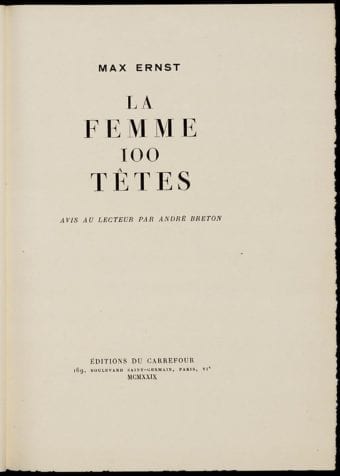
Finally, ancient and modern illustrations were a main source of inspiration for Savinio and Ernst. In 2002, Gerd Roos, in an essay about a new possible iconographical source for Savinio’s hybrid figures, discovered that the artist quoted specific illustrations from the nineteenth-century German album Zer Geschichte der Kostüme (The history of costume) by Braun and Scheider,32 a common practice at the source of Ernst’s collages (figures 16–17).
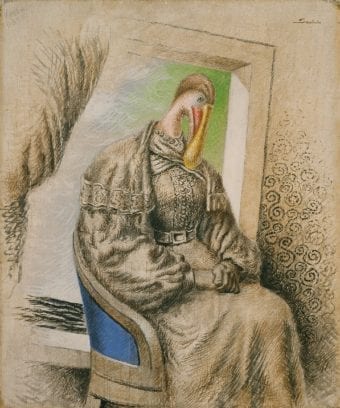
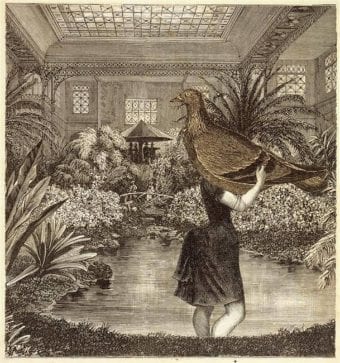
It is clear, then, that although Savinio defined himself conceptually as far from French surrealism, in these Parisian years his iconography had much in common with surrealist aesthetics. Unfortunately, due to the lack of evidence, it is difficult to establish whether Savinio influenced or was influenced by surrealist artists. Concerning Magritte, it seems their dates coincide. Ernst, meanwhile, created images of forests and collages of metamorphosis a few months before Savinio completed comparable works which appear to be inspired by those of the German artist.
Conclusion: Savinio’s reception in the surrealist group
With Savinio’s position towards surrealism clarified, what could be said about his appreciation within the surrealist group? As already mentioned, the artist’s paintings were never exhibited at the Galerie Surréaliste, nor were they reproduced in surrealist publications. Research into the private collections of surrealists, in particular André Breton and Paul Élaurd, has not yet revealed the inclusion of Savinio’s paintings33 – despite the presence of his writings. Breton’s library holds some publications by Savinio from 1918 to 1950: Hermaphrodito (1918); Tutta la vita (A whole life, 1945); Introduction à une vie de Mercure (Introduction to a Mercure’s life, 1945); and Psyché (1950), with drawings by Max Ernst.34
Around 1932, for a catalogue of surrealist publications by José Corti,35 in a table at the end of the document, Savinio was recommended under the heading “lisez” (to read), suggesting that the surrealists considered him more of a writer than a painter. Even if his iconography was close to that of some surrealist painters, his pictorial style and techniques (for example, his use of tempera) were probably seen as insufficiently modern and certainly too close to de Chirico, whose style the surrealists strongly criticized after 1925.
It is possible to conclude, then, that surrealist painting had a much stronger impact on Savinio’s painting than the latter did on the former. In later years, once back in Italy, Savinio would show his ongoing interest in the French movement and its evolution. Even if he would become progressively distant from the practice of painting, some later works show that he was still inspired by surrealism, and making, in his ironic game of citations, explicit homages to old models including Magritte (see Piccolo paradiso [Little heaven], 1939) while also considering some of the newer artists to join the movement, among them Hans Bellmer (figures 18–19).
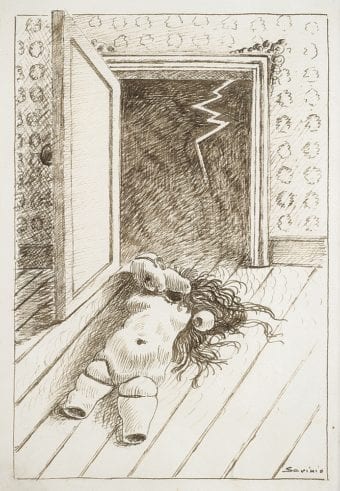
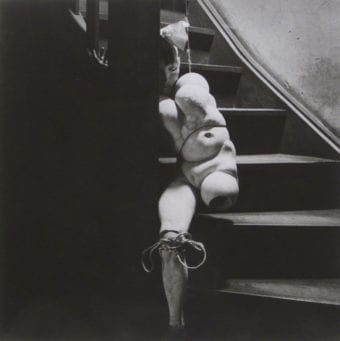
Bibliography
Baldacci, Paolo. Giorgio de Chirico. Gladiatori 1927–1929. Milan: Skira Editore, 2003. Exhibition catalogue.
Baldacci, Paolo, and Pia Vivarelli. Alberto Savinio. Milan: Mazzotta, 2002. Exhibition catalogue.
Breton, André. Anthologie de l’humour noir. Paris: Gallimard, 1940.
Breton, Simone. Lettres à Denise Lévy. Paris: Éditions Joelle Losfeld, Gallimard, 2005.
Derouet, Christian. “La fureur guerrière malgré J. T. Soby est entrée au musée.” In Giorgio de Chirico. La fabrique des rêves. Paris: Éditions Paris Musées, 2009. Exhibition catalogue.
Ensabella, Alice. “‘Non bisogna mescolarsi però ai surrealisti: sono gente cretina e ostile.’ Ricezione e fortuna della pittura dei Dioscuri nella Parigi della fine degli anni Venti.” In De Chirico e Savinio. Una mitologia moderna, 39–49. Cinisello Balsamo: Silvana Editoriale, 2019. Exhibition catalogue.
Ensabella, Alice. “L’arte dei frères voyants. Caratteristiche e dinamiche del mercato artistico attorno al movimento surrealista (1919–1930),” PhD diss., Università di Roma 1 – La Sapienza, Université Grenoble Alpes, 2017.
Ernst, Max. La femme 100 têtes. Paris: Éditions du Carrefour, 1929.
Ernst, Max. Beyond Painting, and other Writings by the Artist and His Friends. New York: Wittenbron, Schultz, 1948.
Exposition Giorgio de Chirico, Galerie Jeanne Bucher. Paris, 1927. Exhibition catalogue.
Fagiolo dell’Arco, Maurizio. Les italiens de Paris. De Chirico e gli altri a Parigi nel 1930. Milan: Skira Editore, 1998. Exhibition catalogue.
Savinio, Alberto. “Achille énamouré mêlé à l’Evergète,” Le Surréalisme au service de la révolution, 5 (May 1933): 32–34.
Savinio, Alberto. “Surrealismo.” La Stampa, July 25, 1934.
Savinio, Alberto. “Surrealismo.” L’Ambrosiano, September 7, 1926.
Savinio, Alberto. Tutta la vita. Milan: Bompiani, 1945.
Savinio, Maria. Con Savinio, ricordi e lettere. Palermo: Sellerio, 1987.
Ottinger, Didier. Magritte, la trahison des images. Paris: Centre Pompidou, 2016. Exhibition catalogue.
Paquet, Marcel. René Magritte, 1898–1967: thoughts rendered visible. Cologne: Taschen, 2012.
Umland, Ann. Magritte: The Mystery of the Ordinary. New York: Museum of Modern Art, 2013. Exhibition catalogue.
Vivarelli, Pia. Alberto Savinio. Rome: Palazzo delle Esposizioni – De Luca, 1978. Exhibition catalogue.
How to cite
Alice Ensabella, “‘Retourner le rêve à la manière d’une chaussette que l’on retire.’ Alberto Savinio and French Surrealism,” in Alberto Savinio, monographic issue of Italian Modern Art, 2 (July 2019), https://www.italianmodernart.org/journal/articles/retourner-le-re%cc%82ve-a-la-maniere-dune-chaussette-que-lon-retire-alberto-savinio-and-french-surrealism/, accessed [insert date].
- The title of this paper draws on the beginning of a text Savinio published in May 1933 in Le Surréalisme au service de la revolution, “Achille Énamouré Mêlé à l’Evergète.” It was his only formal contribution to a surrealist publication or initiative.
- “Il punto di contatto veramente significativo tra Savinio e il movimento francese è proprio nella comune fiducia che l’immaginazione possa essere strumento efficace per un allargamento del concetto di verità […] rivelazione di un meraviglioso che la rottura di una logica assolutizzante fa emergere dal quotidiano.” Pia Vivarelli, Alberto Savinio (Rome: Palazzo delle Esposizioni – De Luca, 1978), 90. All translations in this essay are the author’s.
- Paolo Baldacci, “Savinio e il Surrealismo,” in Paolo Baldacci and Pia Vivarelli, Alberto Savinio (Milan: Mazzotta, 2002), 28.
- See Baldacci and Vivarelli, Alberto Savinio.
- André Breton, Anthology of Black Humor (1940), translated from the French by Mark Polizzotti (San Francisco: City Lights Books, 1997), 287.
- Alberto Savinio, “Surrealismo,” L’Ambrosiano, September 7, 1926; reproduced in Baldacci and Vivarelli, Alberto Savinio, 217.
- Alberto Savinio, “Surrealismo,” La Stampa, July 25, 1934; reproduced in Baldacci and Vivarelli, Alberto Savinio, 217.
- Alberto Savinio, Tutta la vita (Milan: Bompiani, 1945).
- See Baldacci, “Savinio e il Surrealismo.”
- “Notation des plus grands écrivains,” André Breton Archives, available here.
- André Breton, Manifeste du Surréalisme (Paris: Éditions du Sagittaire, 1924).
- Simone Breton, Lettres à Denise Lévy (Paris: Éditions Joelle Losfeld, Gallimard, 2005), 192–93.
- “Cahier de la permanence surréaliste,” André Breton Archives, available here.
- La Révolution surréaliste, no. 2 (January 15, 1925), 15.
- On the reception of Savinio and de Chirico in Paris in the late twenties, see Alice Ensabella, “‘Non bisogna mescolarsi però ai surrealisti: sono gente cretina e ostile.’ Ricezione e fortuna della pittura dei Dioscuri nella Parigi della fine degli anni Venti,” in Alice Ensabella and Stefano Roffi, De Chirico e Savinio. Una mitologia moderna (Cinisello Balsamo: Silvana Editoriale, 2019), 39–49.
- In 1927, Savinio published “Trio” in the February issue of the Bulletin de l’Effort moderne, followed by “Notes sur le cinema” in the April issue. His first painting to be reproduced in the Bulletin was Le rêve du poète (The poet’s dream) in November 1927.
- On Léonce Rosenberg’s apartment, see Christian Derouet, “La fureur guerrière malgré J. T. Soby est entrée au musée,” in Giorgio de Chirico. La fabrique des rêves (Paris: Édiciones Paris Musées, 2009), 135–47; and Paolo Baldacci, Giorgio de Chirico. Gladiatori 1927–1929 (Milan: Skira Editore, 2003).
- Baldacci and Vivarelli, Alberto Savinio, 227.
- Savinio showed with this group for the first time in their second exhibition at the Galerie Zak, in April 1929. For a more detailed chronology, see Maurizio Fagiolo dell’Arco, Les Italiens de Paris. De Chirico e gli altri a Parigi nel 1930 (Milan: Skira Editore, 1998).
- See Maria Savinio, Con Savinio, ricordi e lettere (Palermo: Sellerio, 1987).
- See La Révolution surréaliste, nos. 6–11 (March 1926–March 1928).
- Alberto Savinio, “Achille énamouré mêlé à l’Evergète,” in Le Surréalisme au service de la révolution, no. 5 (May 1933): 32–34.
- For a chronology of the exhibitions and the promotion of surrealism in Paris in the twenties, see Alice Ensabella, “L’arte dei frères voyants. Caratteristiche e dinamiche del mercato artistico attorno al movimento surrealista (1919–1930),” PhD diss., Università di Roma 1 – La Sapienza, Université Grenoble Alpes, 2017.
- La Révolution surréaliste, no. 11 (March 15, 1928): 43.
- Savinio, of course, could have seen Magritte’s paintings at his atelier in the Parisian banlieu, but there is no evidence that he visited it.
- Marcel Paquet, René Magritte, 1898–1967: thoughts rendered visible (Cologne: Taschen, 2012), 8.
- Max Ernst’s essay “Les Mystères de la forêt,” published in Minotaure in 1934, vividly conveys his fascination with various kinds of forests.
- Max Ernst, “Some Data on the Youth of M. E. as told by himself,” in Beyond Painting, and other Writings by the Artist and His Friends (New York: Wittenbron, Schultz, 1948), 27.
- Léonce Rosenberg’s guest book, Léonce Rosenberg Archives, Paris, Centre Pompidou, AM 2000–206.
- Max Ernst, La femme 100 têtes (Paris: Éditions du Carrefour, 1929).
- See Exposition Giorgio de Chirico, Galerie Jeanne Bucher (Paris, 1927).
- Gerd Roos, “Una nuova fonte per l’iconografia di Savinio,” in Baldacci and Vivarelli, Alberto Savinio, 35–53.
- See Ensabella, “L’arte dei frères voyants.”
- See André Breton Archives, available here.
- See “Catalogue: livres et publications surréalistes,” André Breton Archives, available here.

